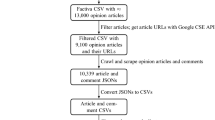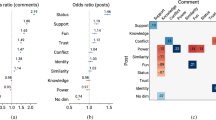Abstract
The paper defines the notion of comment as a communicative act that is not requested by the previous turn and conveys additional information to what has been said before, generally concerning an opinion of its Sender and possibly an evaluation. After distinguishing interpretative versus evaluative comments and focusing on the latter, we characterize a verbal comment as an informative or exclamatory sentence containing an evaluative adjective or other direct or indirect ways to express evaluations. Then, a qualitative study is presented on bodily direct and indirect comments in political debates.



Similar content being viewed by others
References
Becker J (1988) The success of parents’ indirect techniques for teaching their preschoolers’ skills. First Lang 8:173–181
Blum-Kulka S (1990) You don’t touch lettuce with your fingers: parental politeness in family discourse. J Pragmat 14:259–288
De Geer B, Tulviste T, Mizera L, Tryggvason M (2002) Socialization in communication: pragmatic socialization during dinnertime in Estonian, Finnish and Swedish families. J Pragmat 34(12):1757–1786
Brumark Å (2004) Reconsidering comments in family dinner conversations. Rask 2:45–93
Heisler T, Vincent D, Bergeron A (2003) Evaluative metadiscursive comments and face-work in conversational discourse. J Pragmat 35(10–11):1613–1631
Poggi I (2007) Mind, hands, face and body: a goal and belief view of multimodal communication. Weidler Buchverlag, Berlin
Poggi I, D’Errico F, Vincze L (2011) 68 nods. But not only of agreement. Stauffenburg Verlag, Tubingen
Sacks H, Schegloff EA, Jefferson G (1974) A simplest semantics for the organization of turn-taking in conversation. Language 50(4):696–735
Fele G, Paoletti I (2003) L’interazione in classe. Il Mulino, Bologna
Bevacqua E, Pammi S, Hyniewska S, Schröder M, Pelachaud C (2010) Multimodal backchannels for embodied conversational agents. IVA, 194–200
Heylen D (2005) Challenges ahead: head moevements and other social acts in conversations. In: Proceedings of Joint Symposium on Virtual Social Agents. pp 45–52
Poggi I (2004) Emotions from mind to mind. In: Paiva A, Aylett R, Marsella S (eds) Proceedings of the Workshop W13: Empathic Agents. Third International Conference on Autonomous Agent Systems, AAMAS 2004, New York, 19–23 July
Poggi I (1983) La mano a borsa: analisi semantica di un gesto emblematico olofrastico. In Attili e G Ricci Bitti (a cura di) PE (eds) Comunicare senza parole. La comunicazione non-verbale nel bambino e nell’interazione sociale tra adulti. Roma: Bulzoni, 1983, pp 219–238. E in E.Magno Caldognetto e I.Poggi (a cura di): Mani che parlano. Padova: Unipress, 1997
Kendon A (2004) Gesture. Visible action as utterance. Cambridge University Press, Cambridge
Poggi I, Pelachaud C (2008) Persuasion and the expressivity of gestures in humans and machines. In: Wachsmuth I, Lenzen M, Knoblich G (eds) Embodied Communication in Humans and Machines. Oxford University Press, Oxford, pp 391–424
Cassell J, Sullivan J, Prevost S, Churchill E (2000) Embodied conversational agents. MIT Press, Cambridge
Fogg BJ (2003) Persuasive technology: using computers to change what we think and do. Morgan Kaufmann, San Francisco
Dovidio JF, Brown CE, Heltman K, Ellyson SL, Keating CF (1988) Power displays between women and men in discussions of gender-linked topics: a multichannel study. J Pers Soc Psychol 55:580–587
Acknowledgments
Research supported by SSPNet Seventh Framework Program, European Network of Excellence SSPNet (Social Signal Processing Network), Grant Agreement N.231287.
Author information
Authors and Affiliations
Corresponding author
Rights and permissions
About this article
Cite this article
Poggi, I., D’Errico, F. & Vincze, L. Comments by words, face and body. J Multimodal User Interfaces 7, 67–78 (2013). https://doi.org/10.1007/s12193-012-0102-z
Received:
Accepted:
Published:
Issue Date:
DOI: https://doi.org/10.1007/s12193-012-0102-z




